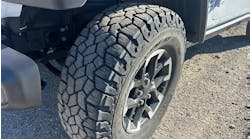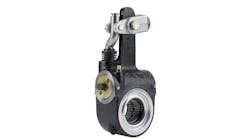After taking one on the chin courtesy of the COVID-19 pandemic, the U.S. commercial tire industry is bouncing back in 2021. Because of the pandemic and lockdowns, motor vehicles overall in the U.S. traveled 13.2% fewer miles in 2020 compared to 2019, which equates to less wear and tear on tires and less need for new ones.
Now the economy is ready to grow again, and commercial trucks are in high demand, with June spot rates up 101% year over year, according to DAT Freight & Analytics. And FTR Transportation Intelligence forecasted a 14.5% YOY increase in freight for the second quarter of 2021, with a 7.1% increase expected for Q3 and 5.8% for Q4. The demand for tires seems to back up this growth.
“The tire market was booming during Q1 of 2021, with truck replacement shipments up 11% year over year, primarily among U.S. Tire Manufacturing Association members who are up 12.5% year over year,” said Tom Fanning, Continental’s head of U.S. market, truck tires. “Booming growth will continue for Q2, especially when compared to 2019.”
While the economy is growing again, there has been a restructuring of route distribution, with last-mile delivery operations gaining market share. According to the Customized Logistics and Delivery Association white paper The Age of Amazon: Why 3PLs & Last-Mile Delivery Fleets Must Draw Closer, ecommerce in North America jumped 44% in 2020, a side effect of the lockdowns. The trend shows no signs of reversing, as this white paper also projects last-mile delivery will have a compound annual growth rate of 14% from 2020 to 2024, when it will reach $44.88 billion.
“Over the past decade, we have witnessed the volume of truck tires for the regional application continuing to increase year in and year out, nearing long-haul volumes,” Fanning said. “This has not been seen in the U.S. market in recent memory. As soon as the next five to 10 years, regional tire shipments are expected to eclipse long-haul volumes.”
Supply chain issues still complicate matters. First, Southeast Asia’s rubber-producing countries of Malaysia and Thailand were not able to use migrant workers to tap the rubber trees because of travel restrictions between nations. Fungal leaf disease has also impacted the production of natural rubber, which comprises about one-third of a truck tire. Production was down 10% in 2020, which caused rubber prices to rise 70% YOY in May of this year to $2.29/kg, according to the Singapore Commodity Exchange.
“Tires are hard to come by right now; you’ve got higher prices and lower supplies,” noted Kevin Rohlwing, SVP of training for the Tire Industry Association (TIA). “We can’t say it’s a shortage, but in certain sizes and certain styles, you’re not going to be able to get them.”
The problem, Rohlwing explained, is that because there are so many types of commercial tires with different sizes and treads, requiring different steel casings and rubber compounds, manufacturers can’t always pivot quickly to produce them when customer demand increases.
Rohlwing pointed out that “wherever weak demand is increasing the most” is where shortages will crop up. In response, tire manufacturers are raising prices. In March, Goodyear Tire & Rubber Co. announced it would increase passenger tire prices, while Bridgestone, Continental, Michelin, and Yokohama have upped the cost of their commercial tires. Yokohama cited an “unprecedented increase in the cost of raw materials, and the ongoing rise of operational costs necessitated the price adjustments.”
“Disruption in the supply chain coupled with decreased production in 2020 will lead to supply shortages throughout 2021,” Fanning said of Continental specifically. “As a global manufacturer, we are sourcing tires from our global production network to supplement local supply, but the container shortage will also impact the speed and availability of these deliveries.”
Today’s challenges are tomorrow’s opportunities, though, and the shocks brought about by COVID-19 are teaching the commercial vehicle tire industry how to better absorb such blows in the future. And by the end of the decade, the process of how an average fleet procures, manages, and maintains tires is shaping up to look radically different. On every front, from gathering data to recycling spent rubber, innovation within the commercial tire industry is gaining traction.
As material science engineers tinker in the lab to improve tire durability and performance, supply chain experts are busy innovating ways to make it easier to track the tire lifecycle and get every last mile possible out of each tire, whether it be an 18-wheeler or battery-electric delivery van. And when a tire is worn out, the industry is looking at economical and sustainable ways to keep all that rubber out of landfills via retreading and recycling.
This is all great news for commercial fleets, as tires are typically the top expense after fuel and labor costs. The downside is that, for now, access to these benefits largely relies on more investment, testing, training, and employee buy-in. Employing those are standard operating procedure for large fleets, though elevation or temperature.
Fortunately, as the decade progresses, these barriers to adoption will thin, as typically happens with new technology and equipment. That means any fleet owner will be able to unlock more efficiencies sooner rather than later. To help guide fleets on what options to investigate, we asked tire experts to share their insights on the anticipated technology trends that will help drive these changes. And it all starts with something all fleets have plenty of—data.
Digital tire tracking trends
Spurred by the onset of telematics, access to more data has transformed trucking operations in the past decade. The first areas to see the efficiency improvements were in the cab with the driver and under the hood with the powertrain. In this next decade, tires will get their turn.
“Tire manufacturers are developing these new intelligent tires that can give you all sorts of performance in real-time; pressure, speed, temperature, you name it,” said Robert Braswell, executive director for the American Trucking Associations’ Technology & Maintenance Council (TMC). “And those tires are sending their information back to the office through telematics, so the fleets have visibility of what’s going on. That’s a revolution in fleet tire management.”
TMC attributed tire failures to more than half of truck roadside breakdowns, with underinflation playing a pivotal role.
“You have to have sufficient inflation pressure for the load being carried, and that’s not always the easiest thing to determine,” Braswell said, noting that tire suppliers have complex inflation data tables that dictate proper inflation related to axle ratio and weight rating of the load.
“In the old days, they used a thumping stick, which is completely useless. Then, we migrated to using tires that are calibrated to a master gauge—very labor-intensive,” Braswell said.
“One misconception within the industry is that once you inflate commercial tires to the recommended specification, they do not need to be attended to for a long period of time,” noted Bridgestone Applications Engineer Greg Kidd. “The reality is that air will permeate out of the tire at a rate of 2 psi per month and inflation will also be impacted by any dramatic change in elevation or temperature. It is imperative that drivers regularly check their tire’s psi pre- and post-trip for a safe journey.”
The advent of tire pressure monitoring systems and automatic tire inflation systems has helped the underinflation problem.
“Customers looking for the lowest overall driving cost should strongly consider a digital TPMS, as properly inflated tires get 15% longer tread life on the tire’s first life, and 20% longer casing life for retreading,” Fanning said. “One customer has told us they have reduced roadside service calls to zero by implementing our ContiConnect Yard solution. This type of service around the tire helps our customers maximize their tire investment and reduce downtime.”
The more smart tires there are, the more fleets can leverage the data they gather. Michelin, for instance, equips 90% of its truck tires with radio-frequency identification (RFID) chips to help fleets locate and monitor their supply in the warehouse and on the road. This real-time tire data also can reveal insights into road conditions along the route.
“It’s about being proactive and seeing the early signs that could indicate a failure down the line,” said Pierluigi Cumo, marketing director for on-road at Michelin. “We have offers to address the emergency aspect with ONCall (end-to-end breakdown solution), but we also want to use that data to see maybe there's specific spots that fleets need to pay particular attention to.”
Cumo added a secondary function of On-Call is being able to confirm the location of replacement tires to ensure product availability in the event a truck or trailer were to get a flat on the road. “Fleets can optimize how they spread their inventory to make sure that they have the ability to put the truck back on the road quickly if something happens,” he offered.
This is a drastic improvement over the conventional way of tracking via manual inventory.
“Before, fleet managers would track tire usage by unit number. They know who the driver is, and they know the routes that they're running and for some reason, this particular unit goes through a lot more tires than this other one, so then they begin to try to figure out what's going on,” said Kyle Chen, channel manager for fleet and OE TBR at Bridgestone Americas. “But now with some of the new technologies they can home in on some of that much quicker. It does come down a lot of times to the individual driver and how well they're trained.”
In addition, Goodyear has brought this visibility to other commercial vehicles. The Goodyear SightLine, which launched in June, allows for a more predictive view of cargo vans, addressing the significant increase of e-commerce and rapid growth in the last-mile sector.
“Much like smartwatches that monitor vitals like heart rates and oxygen levels, Goodyear SightLine’s tire intelligence.
monitors the health of a tire,” said Chris Helsel, Goodyear’s senior vice president of global operations and chief technology officer. “[It] takes the mystery out of understanding tires and communicates when tires need service or replacement.”
The Goodyear SightLine platform measures pressure, friction, leaks, and road conditions such as slickness. An updated version is expected to communicate road conditions to other vehicles as well. According to Goodyear’s initial testing, integrating SightLine technology into a vehicle control system can reduce stopping distance loss by 30%. Goodyear, which in June completed its acquisition of fellow Ohio-based tire manufacturer Cooper Tire & Rubber Company, also has its Complete Tire Management solution, which pulls in digital inspection information to gather pressure, depth, and wear data with real-time alerts to help fleets stay ahead of issues and avoid breakdowns. Michelin Tire Care and Bridgestone IntelliTire provide similar services.
Stay tuned for part two, where we'll discuss some of the latest trends in retreading and efficiency.
This article originally appeared on FleetOwner.com.






